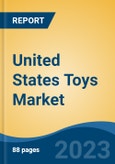Free Webex Call
The United States Toys Market was valued at USD 27.89 Billion in 2024 and is projected to reach USD 36.85 Billion by 2030, rising at a CAGR of 4.75%. As one of the most vibrant and expansive toy markets globally, it benefits from robust consumer spending, strong brand presence, and continuous product innovation. The market is propelled by rising disposable incomes, seasonal demand spikes during holidays, and increasing preference for educational and tech-enhanced toys. Major players such as Hasbro, Mattel, and LEGO dominate the landscape, while newer entrants focus on sustainability and digital integration. The growth of e-commerce, especially after the pandemic, has significantly widened market accessibility and purchasing convenience. Speak directly to the analyst to clarify any post sales queries you may have.
10% Free customizationThis report comes with 10% free customization, enabling you to add data that meets your specific business needs.
Key Market Drivers
Strong Consumer Spending and High Disposable Income
The U.S. toys market is heavily influenced by high consumer spending and substantial disposable incomes. In 2024, monthly increases in real disposable income of over 3% underscore a favorable economic backdrop. American households consistently prioritize spending on children’s products, including toys, recognizing their dual role in entertainment and development.Cultural traditions such as gift-giving during holidays and birthdays further bolster demand. Additionally, many parents are inclined to purchase premium educational toys, reflecting a cultural emphasis on enriching childhood experiences. Demographic trends like increasing birth rates in some regions and the rise of dual-income families enhance purchasing capacity and encourage the acquisition of branded, high-quality toys. These factors collectively ensure steady demand, especially during peak festive seasons.
Key Market Challenges
Rising Competition from Digital Entertainment and Screen-Based Activities
A major challenge for the U.S. toys market is the growing preference among children for screen-based entertainment. With easy access to smartphones, tablets, and streaming platforms, traditional toys face stiff competition from mobile games and digital media. This shift reduces the time children spend with physical toys and impacts demand, especially for non-digital products.The popularity of cost-effective digital content puts traditional toy makers in direct competition with tech companies that have more substantial innovation budgets. Additionally, educational apps and e-learning tools are increasingly favored by parents over physical toys. This pushes manufacturers to integrate digital elements, often raising production costs. Brands that fail to adapt risk becoming obsolete, particularly as attention spans shorten and expectations evolve.
Key Market Trends
Surge in Demand for Educational and STEM-Based Toys
There is a growing trend among American parents to invest in educational and STEM-based toys that promote early learning and skill development. Toys that support cognitive, motor, and problem-solving abilities - such as coding kits and science experiments - are increasingly in demand. Companies like LEGO Education, Osmo, and Learning Resources are meeting this demand with innovative products aligned with school curricula. The pandemic-driven rise in home-based learning accelerated interest in such toys, which now serve as essential tools for supplementing education. Greater awareness of the importance of STEM skills for future careers further fuels this trend, encouraging manufacturers and retailers to expand their offerings in this category and collaborate with educators.Key Players Profiled in this United States Toys Market Report
- Hasbro Inc.
- Mattel Inc.
- Spin Master
- MGA Entertainment Inc.
- Radio Flyer
- K’Nex Industries Inc.
- Funko Inc.
- LEGO Group
- Vtech
- Ravensburger
Report Scope:
In this report, the United States Toys Market has been segmented into the following categories, in addition to the industry trends which have also been detailed below:United States Toys Market, by Product Type:
- Outdoor and Sports Toys
- Dolls
- Vehicles Toys
- Plush Toys
- Others
United States Toys Market, by Distribution Channel:
- Supermarkets/Hypermarkets
- Specialty Stores
- Online
- Others
United States Toys Market, by Region:
- South
- West
- Midwest
- Northeast
Competitive Landscape
Company Profiles: Detailed analysis of the major companies present in the United States Toys Market.Available Customizations:
With the given market data, the publisher offers customizations according to a company's specific needs. The following customization options are available for the report.Company Information
- Detailed analysis and profiling of additional market players (up to five).
This product will be delivered within 1-3 business days.
Table of Contents
1. Introduction
2. Research Methodology
3. Executive Summary
4. United States Toys Market Outlook
5. United States Outdoor and Sports Toys Market Outlook
6. United States Dolls Market Outlook
7. United States Vehicles Toys Market Outlook
8. United States Plush Toys Market Outlook
9. Market Dynamics
10. Market Trends & Developments
12. Competitive Landscape
Companies Mentioned
The leading companies profiled in this United States Toys market report include:- Hasbro Inc.
- Mattel Inc.
- Spin Master
- MGA Entertainment Inc.
- Radio Flyer
- K’Nex Industries Inc.
- Funko Inc.
- LEGO Group
- Vtech
- Ravensburger
Table Information
| Report Attribute | Details |
|---|---|
| No. of Pages | 85 |
| Published | May 2025 |
| Forecast Period | 2024 - 2030 |
| Estimated Market Value ( USD | $ 27.89 Billion |
| Forecasted Market Value ( USD | $ 36.85 Billion |
| Compound Annual Growth Rate | 4.7% |
| Regions Covered | United States |
| No. of Companies Mentioned | 11 |









